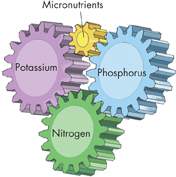Nutrient Limitation in Soil In all but the richest soil, the growth of crop plants is typically limited by one or more nutrients that must be taken up by plants through their roots. That's why farmers use fertilizers! Most fertilizers contain large amounts of nitrogen, phosphorus, and potassium, which help plants grow better in poor soil. Micronutrients such as calcium, magnesium, sulfur, iron, and manganese are necessary in relatively small amounts, and these elements are sometimes included in specialty fertilizers. (Carbon is not included in chemical fertilizers because plants acquire carbon dioxide from the atmosphere during photosynthesis.) All nutrient cycles work together like the gears in Figure 3–20. If any nutrient is in short supply—if any wheel “sticks”—the whole system slows down or stops altogether.
Nutrient Limitation in Aquatic Ecosystems The open oceans of the world are nutrient-poor compared to many land areas. Seawater typically contains only 0.00005 percent nitrogen, or 1/10,000 of the amount often found in soil. In the ocean and other saltwater environments, nitrogen is often the limiting nutrient. In streams, lakes, and freshwater environments, phosphorus is typically the limiting nutrient.
Sometimes, such as after heavy rains, an aquatic ecosystem receives a large input of a limiting nutrient—for example, runoff from heavily fertilized fields. When this happens, the result can be an algal bloom—a dramatic increase in the amount of algae and other primary producers. Why can runoff from fertilized fields produce algal blooms? More nutrients are available, so producers can grow and reproduce more quickly. If there are not enough consumers to eat the algae, an algal bloom can occur, in which case algae can cover the water's surface and disrupt the functioning of an ecosystem.
VISUAL ANALOGY
INTERLOCKING NUTRIENTS

Figure 3–20 The movement of each nutrient through ecosystems depends on the movements of all the others, because all are needed for living systems to function. Use Analogies If these gears were modeling nutrient cycling in the ocean, which gear would typically determine how quickly—or slowly—all the other gears turn?
3.4 Assessment

-
Review How does the way that matter flows through an ecosystem differ from the way that energy flows?
Apply Concepts What are the four types of processes that cycle matter through the biosphere? Give an example of each.
-
Review By what two processes is water cycled from land to the atmosphere?
Sequence Describe one way in which water from the ocean may make one complete cycle through the atmosphere and back to the ocean. Include the names of each process involved in your cycle.
-
Review Why do living organisms need nutrients?
Predict Based on your knowledge of the carbon cycle, what do you think might happen if humans were to continue to clear and burn vast areas of forests for building?
-
Review Explain how a nutrient can be a limiting factor in an ecosystem.
Apply Concepts Look back at the nitrogen and phosphorus cycles (Figures 3–18 and 3–19). How is fertilizer runoff related to algal blooms?
WRITE ABOUT SCIENCE
Describe how oxygen, although it does not have an independent cycle, moves through the biosphere as part of the carbon cycle. Include a description of the various forms that oxygen takes.

Table of Contents
- Formulas and Equations
- Applying Formulas and Equations
- Mean, Median, and Mode
- Estimation
- Using Measurements in Calculations
- Effects of Measurement Errors
- Accuracy
- Precision
- Comparing Accuracy and Precision
- Significant Figures
- Calculating With Significant Figures
- Scientific Notation
- Calculating With Scientific Notation
- Dimensional Analysis
- Applying Dimensional Analysis




